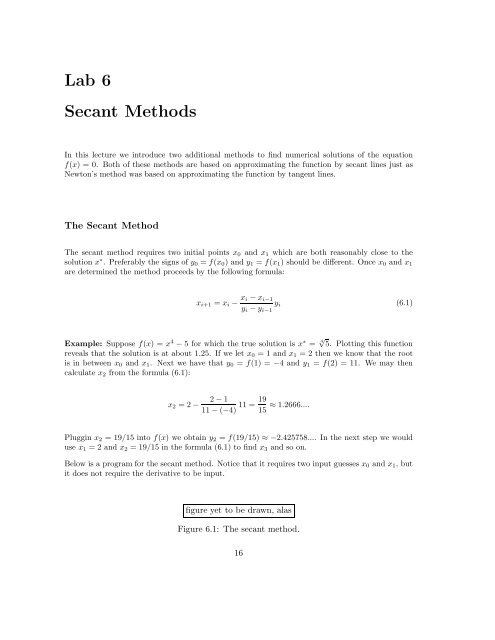Introduction to Numerical Math and Matlab ... - Ohio University
Introduction to Numerical Math and Matlab ... - Ohio University
Introduction to Numerical Math and Matlab ... - Ohio University
You also want an ePaper? Increase the reach of your titles
YUMPU automatically turns print PDFs into web optimized ePapers that Google loves.
Lab 6<br />
Secant Methods<br />
In this lecture we introduce two additional methods <strong>to</strong> find numerical solutions of the equation<br />
f(x) = 0. Both of these methods are based on approximating the function by secant lines just as<br />
New<strong>to</strong>n’s method was based on approximating the function by tangent lines.<br />
The Secant Method<br />
The secant method requires two initial points x 0 <strong>and</strong> x 1 which are both reasonably close <strong>to</strong> the<br />
solution x ∗ . Preferably the signs of y 0 = f(x 0 ) <strong>and</strong> y 1 = f(x 1 ) should be different. Once x 0 <strong>and</strong> x 1<br />
are determined the method proceeds by the following formula:<br />
x i+1 = x i − x i − x i−1<br />
y i − y i−1<br />
y i (6.1)<br />
Example: Suppose f(x) = x 4 − 5 for which the true solution is x ∗ = 4√ 5. Plotting this function<br />
reveals that the solution is at about 1.25. If we let x 0 = 1 <strong>and</strong> x 1 = 2 then we know that the root<br />
is in between x 0 <strong>and</strong> x 1 . Next we have that y 0 = f(1) = −4 <strong>and</strong> y 1 = f(2) = 11. We may then<br />
calculate x 2 from the formula (6.1):<br />
x 2 = 2 − 2 − 1 19<br />
11 =<br />
11 − (−4) 15 ≈ 1.2666....<br />
Pluggin x 2 = 19/15 in<strong>to</strong> f(x) we obtain y 2 = f(19/15) ≈ −2.425758.... In the next step we would<br />
use x 1 = 2 <strong>and</strong> x 2 = 19/15 in the formula (6.1) <strong>to</strong> find x 3 <strong>and</strong> so on.<br />
Below is a program for the secant method. Notice that it requires two input guesses x 0 <strong>and</strong> x 1 , but<br />
it does not require the derivative <strong>to</strong> be input.<br />
figure yet <strong>to</strong> be drawn, alas<br />
Figure 6.1: The secant method.<br />
16
















